
File Photo
Non-woven wallpaper, also called non-woven wallpaper, is a type of high-grade wallpaper. Because it is made of natural plant fiber non-woven technology, it has strong tensile strength, is more environmentally friendly, does not mold and yellow, and has good air permeability. level.
How to paste non-woven wallpaper:
1. Wall treatment
The wall surface should be flat, clean, dry, and of uniform color.
2. Cut the wallpaper
Arrange the wallpaper according to the serial number of the wallpaper, measure the height of the wall, and cut the wallpaper according to the height of the top and bottom of the wall. Be sure to cut one roll of wallpaper at a time to prevent quality issues.
3. Brush Wallpaper glue
Non-woven wallpaper glue must be brushed evenly on the wall with a thickness of 2 mm. Never brush glue directly onto the back of a woven fabric, soak it in water. Different from other wallpapers, non-woven fabric should have thicker and thicker glue than other wallpapers, making it less fluid.
4. Paste the wallpaper
Post the non-woven wallpaper in the order it was previously compared
5. Cutting construction wallpaper
It is necessary to overlap the edges and cut the construction. The specific method is to overlap the edges during construction. The number of edges depends on the pattern. After confirming that the pattern is aligned, press down with a ruler on the overlapping area to cut, try to avoid cutting the outer corner, so that the edge of the wallpaper is not in the outer corner, and make sure the cutting knife is sharp when cutting, and there should be no burrs, at the same time, pay attention to the strength of the knife, so that a cut and a knife break, but not too much damage to the wall surface.
6. Clean the wallpaper after sticking
If there is dust on the surface after construction, use a small-bristled brush or broom to shake it off, and do not wipe with a wet towel to spread contamination.
Precautions for sticking non-woven wallpaper:
1. During construction, after the base coating layer has dried, draw a vertical line as a standard to avoid the wrong positioning of the wallpaper paste.
2. Do not use a hard scraper or nylon brush after wallpapering the wall. You should use a soft brush to gently scrape from top to bottom to smooth the surface of the woven fabric to remove air bubbles and wrinkles. Do not scrape the glue from the seam to avoid contamination. If the glue accidentally squeezes from the surface, immediately wipe it with a dry towel and try to keep your hands clean during construction.
3. During construction, inspection should be done at the same time as construction. If problems are found, construction must be stopped immediately and causes and solutions must be found before construction.
Source: Online/NAN
Comment Now